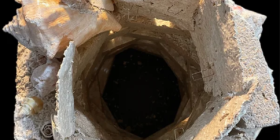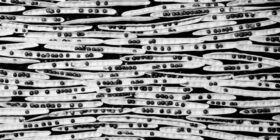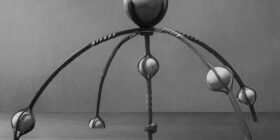Tactile Maps
Driven by her desire to “know the world,” Ingrid Calame has been tracing the marks on its surface, turning them into intricate paintings, drawings, prints, and murals, for nearly 20 years. As she explains: “the idea was that the whole surface of the world is a potential drawing. I can’t trace the whole world, so I’m tracing a fragment. I’m interested in how impossible it is for us to represent something as huge as the world.”
Introduction: The Dawn of the Tactile Map
As a child I always wanted to make a map of the world that would articulate every detail of it. By re-presenting the world I would become a bit more like God who, I imagined, was controlling the events and people around me. I did not think of this as a personal map reflecting my journey through the world, because I was not aware of my own subjectivity. With my sharpened 2B pencil I would start drawing images from my imagination at the corner of a large piece of paper. Soon, with only an inch or two drawn, I would weary of this daunting task and give up.
It was in 2008, when I was forty-eight years old and fourteen years into my process of investigating abstraction and representation, that I came to realize that I was deep in the middle of creating this implausibly detailed map. It was just as daunting a task as when I was a kid but the very grandeur of the impossibility of its completion was a fundamental tenant of my project as an adult. The contrast of my meticulous documentation of the world with a 2B pencil with the open-endedness of the possibility of completion suited profound questions I have in my life: How do I know what I know? How do I walk through my life with a sense of wholeness when my understanding is so fragmentary and subjective? How does this bit of the world I see connect with the larger world of which I know but cannot see or understand?
The realization of this correlation between my childhood desire to map and my artmaking strategies came on the heels of giving birth to my daughter. Her birth, a shift in the tectonic plates of my life, made the task of pinning life down more impossible and opened up questions of time to my thinking about mapping. In 2014 my ruminations on this came to fruition in frottage (rubbing) drawings that I call tactile maps.
Mapping 1: 1994-1997 — Shphloo

Lup Bup Zhir Pow, 61 cm x 61 cm, enamel paint on aluminum, 1994
Mapping started quite simply for me in the summer of 1994. I did not know that I was launching an investigation that would continue for years. I traced thirty of my old paint stains on the studio floor, from which I began to make one painting per day using various configurations. I used tracing paper to document the cartoon-like bulbous forms that I then transferred to a panel and filled in with enamel paint like in a coloring book.
As I made one painting after another using these thirty shapes, I realized I was using a language of forms. I was interested in the fundamentals of abstraction in our daily life: how we put our knowledge of the world together and understand it as a cohesive whole. What was developing was a painting system in which I could look at both part and whole. Language is one magnificent arena of increments building to coherence. Semiotics became my model for abstract painting.
Studying filmmaking at the time, I was conscious of painting’s body-centric rather than camera-centric process. One-to-one scale translation is antithetical to image-making in photographic and digital media. One–to-one scale became my arena of thought in painting, a good way to look at abstraction from the other side of a photographic looking-glass.
In 1995 I expanded my project by combining shapes with each other to form new shapes. I named the shapes with onomatopoetic words, a linguistic representation of their making, giving them a duration of articulation. Then, to make a painting, I would lay the tracings on the floor in a constellation. I titled the paintings based on the location of the shapes within the constellation excerpt. The title offered another moment of their construction in the viewer’s imagination. All of the works titled with sounds I called “Shphloo.”

PRACK!: oip BINK splew-floa SPOO!, 61 cm x 61 cm, enamel on aluminum, 1995
Mapping 2: 1998-2014 – Tracing the Street
In the summer of 1998 my cousin Gillian visited and told me about my grandmother’s death several years before. Her body was found days after she died, her remains a visceral puddle of smells, stains and detritus. The connection of the liquidity of our bodies and the loss of my grandmother propelled me out of the studio and into the street to trace stains. I was about to have a show at POST gallery in downtown Los Angeles, so I chose the gallery’s desolate industrial dead-end as the location of my first street tracings.
The comments I heard on the resulting piece “Spalunk “ startled me. Instead of people recognizing the marks as indexical to the street, they thought that the work was a result of action painting. This discovery made me even more interested in the process of tracing as a nexus between an indexical, representational mark and what we have come to see as an abstract mark in painting.

Spalunk, 97 cm x 412 cm, enamel on Mylar, 1997. installed at POST, Los Angeles, CA.
After this show I began making color pencil drawings from the constellations of tracing marks from streets and sidewalks. These color pencil drawings replaced the onomatopoetic names I had been giving to individual shapes. Instead, each traced stain in a drawing would be delineated by the same color line. In the paintings that I would make from a direct transfer of the drawings, I would mix up a color to delineate all parts of each stain.
I used the tracings in three bodies of work all at one-to-one scale. The relationship between the different bodies of work is where the abstraction lies. Each work describes the information in different ways: The color pencil drawings work like an x-ray, the paintings like an illuminated intersection of surfaces, and the constellation is a silhouette of the overall shape.

‘#8 Working Drawing’, 77 cm x 77 cm, color pencil on trace Mylar, 1997

”OM splink”, 61 cm x 61 cm, enamel on aluminum, 1997

“b-b-b, g R-UF!, b-b-b”, enamel paint on trace Mylar, 884 cm x 762 cm, 1999
Mapping 3: 2001-2006 — Secular Response
The surface of the world began to evolve as my subject matter, my whole from which to extract parts, like Borges’s “Map of the Empire whose size was that of the Empire.” The tracings are like the top layer of world’s skin. It is a given that my tracings are fragmentary because it would be impossible to trace the whole world, but each fragment implies the whole. Marks on the ground can be deceptively large. Because of the limits of our perspective, the shift when I transferred a tracing from floor to wall was full of surprises. Tracing is the only way that I could gather this particular information with this effect: In the scale that I am working at, cameras subject the ground to perspective. Tracing uses my body as the most efficient instrument of transcription for the marks and stains.
I began to wonder why the gallery should form the limits of the constellations’ size. I was interested in how religion, economics, and science along with art inform our sense of mortality, therefore I thought the walls of buildings that represent these three métiers should be the frame for my tracings of street stains. I chose my home town church Ardsley United Methodist Church (Secular Response 1), the New York Stock Exchange (Secular Response 2) and the Lowell Observatory, Flagstaff, AZ (Secular Response 3).
For Secular Response 2 I drew the 15,000 square-foot silhouette of a constellation of stains (traced from Las Vegas, Los Angeles, and Wall Street) I placed on the floor of the NYSE with round-the-clock help from assistants from around the country. It took two weekends in May 2001. I brought the drawing back to the studio and painted several works from it over the next couple of years. In Secular Response 2A.H the white forms are the shapes of the posts and booths of the stock exchange—they are the negative space surrounding the tracings.
In Secular Response I used these three buildings as viewfinders for the landscape of stains I was collecting. The architectural footprint of each building reflects the flow of human traffic that the activity within it demands: the walls of intention contained street tracings of incident and accident.

Tracing in the New York Stock Exchange, May 2001 (photo Shelby Roberts)

“Secular Response 2A.H”, installed at the Kunstverein Hannover, enamel paint on trace Mylar, 376 cm x 2,987 cm, 2004
Mapping 4: Tracing the Surface of the World
The tracings continued to get increasingly intricate. My subjects ranged from the Indianapolis Motor Speedway to the Los Angeles River, to the shipping floors of ArcelorMittal Steel, Lackawanna, NY. When I traced I discerned the edge of one thing from another: an inside and an outside, a beginning and an end. They were extremely meticulous but also highly subjective, as stains are not black and white images with clear borders.
Each shape was found and unique; only the method of capture remained the same between them. I began to fantasize: what if language was made up of letters that were infinite and different every time? I disentangled each shape from the world, isolating it and making it legible before it was washed away by the rain or covered up by the graffiti cops.

#258 Drawing (Tracings from the Indianapolis Motor Speedway and the L.A. River 222 x 344 cm, color pencil on trace Mylar, 2007

Calame painting “From #258 Drawing (Tracings from the Indianapolis Motor Speedway and the L.A. River)”, enamel paint on aluminum, 183 cm x 305 cm, 2007 (photo Shelby Roberts)
Mapping 5: 2015-2017 — The Tactile Map

Ingrid Calame in Lacoste Cistern for the first time, 2013 (photo Shelby Roberts)
In the summer of 2013 I visited Lacoste, France where I saw a Neolithic cistern—a cave with niches carved out. The natural phenomenon of the mountain weeping water from its core provided the water for the cistern. As the human habitation on the mountainside grew into the medieval city of Lacoste, the city was built around the cisterns as a water source. The cisterns were the inner core of the city and were the place of retreat from enemies; when the defensive walls of the city would be attacked, the townsfolk would retreat toward the cisterns that provided water and shelter. The beauty of the form reminded me of the human body and the story of the cisterns echoed within me. I had a dream about asking for a cup of water in a Dairy Queen soft-serve ice cream restaurant. The DQ worker refused to give it to me. I had to defend myself in front of a room of people, as to a jury, about my need for this water.
A year later I was in the cistern trying to figure out how to make rubbings of this place – first on muslin, then rice paper and then finally Mylar gave me enough resistance to give me an almost photographic representation. I tried charcoal, pastel and finally raw colored pigment to make the marks. It launched a whole new kind of mapping for me: a tactile map that was made through the action of rubbing itself – the action of exploring the form is its documentation.
As animals knowing through touch precedes knowing through sight. In the uterine confines of the cistern, with its undulating surface of bulges and indentations, I realized that if I remembered the beginning of life as a fetus and my own birth, it would be through the push of my body against the surface of my mother’s uterus. My developing eyes may or may not have been able to see light through the darkness of the womb. Did I turn toward light that filtered through her uterine wall and skin? In the soft pull of the raw pigment marks on Mylar the travels of my hand over the rock surface is a kind of imaginative remembering of being in utero.
I was only semi-aware of this aspect of my drawing process while I was making them in Lacoste. While I joked at the time that we were exploring a giant uterus, it wasn’t until looking at the drawings back in my studio that I fully understood what I had been doing in the cistern.

#658 Drawing (Lacoste Cistern), 72 cm x 72 cm, pigment on Mylar, 2014
Birth is the quintessential moment of abstraction and not-abstraction. Everyone living was born into this world, but our relationship to our own birth is mediated through memory, language and representation. In the artist book Being Born, a Joachim Keinbaum book published by Snoeck, Germany in 2016 (https://www.amazon.com/Ingrid-Calame-Being-Jochen-Kienbaum/dp/3864421594 ) I paired my Lacoste drawings with interviews I conducted with people from seven to ninety-seven years old, recalling their birth. I was interested in the interviewees’ relationship to their own birth. Accuracy and actual remembering was not what I desired or expected but rather their recollections, thoughts, dreams, as well as their own stories and stories that they inherited. I wanted company in the experience of imagining being born.
Gathering these stories moved my tracing from the surface of the world to the surface and dimension of time. The thoughts and memories of the people I interviewed reach back to touch upon all aspects of history, from trends in culture, to historical events, to gestures and identities passed down in the personal histories of families. It is a mapping of history in a lattice-like structure similar to the rubbings themselves. They touch all points of time non-linearly in a net of molecular information.

Calame creating a rubbing at the Stiftung Zollverein, 2015
While interviewing people and making the book I made rubbing drawings at the Stiftung Zollverein, Essen, Germany. Inspired by my seven-year-old daughter’s fear while watching the film “Modern Times” (when Charlie Chaplin, an assembly line worker, is sucked on the conveyor belt into the cogs and wheels of the machine that he is working on), I saw the giant machines of this historic coal-washing plant as a monument to the utopia and dystopia of the Mechanical Age. The giant dark machines seem nostalgically large and simple from the perspective of our current age of iPhones – tiny digital machines extending our bodies into space.
While making rubbings in the Zollverein, I used my whole body to know the forms: it was a dance with the inert machines – out of service, out of time. My gestures with the little bags of pigment documented the way that my body circumscribed the form, pushing into and out of the machines’ grooves and spokes. The drawing is a one-to-one scale map that includes my body in its representation: the object in front of me and the arcs and twists of my body in experiencing it, the way that my hand feels for it with color.
Conclusion: Re-presenting Abstraction
When I was three-years old and had just learned to use a pair of scissors, I had a pivotal conceptual moment. I drew a stick figure with a big round head. Cutting along the lines of the body up to its head I was left with just the circle of the head in my hands and a bunch of chunks of paper – not the figure I had planned on at all! Since then I have felt this disintegration of an intended representation often: the line I have drawn disappears in trying to make it more real. But it is this experience of drawing and cutting, re-presenting and representing the abstraction that makes me feel more real.

………………..
All images copyright and courtesy of Ingrid Calame
Get the Full Experience
Read the rest of this article, and view all articles in full from just £10 for 3 months.



No comments yet.